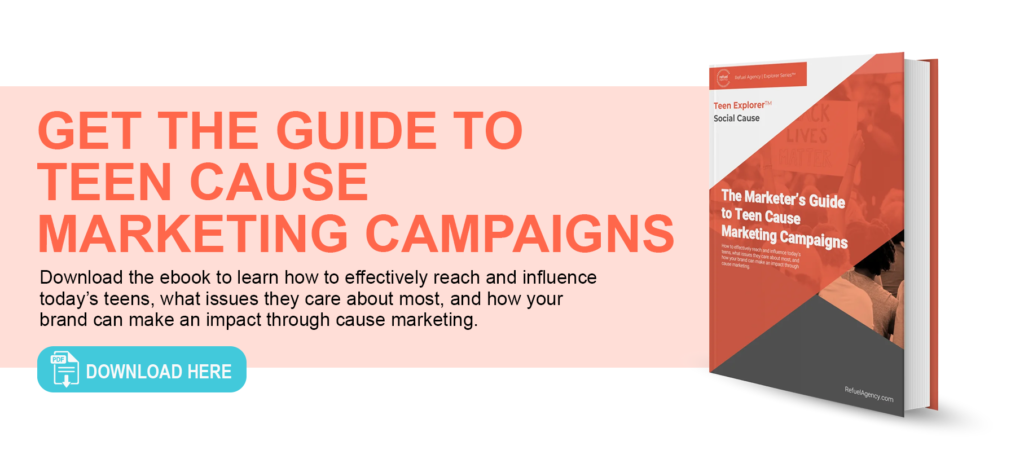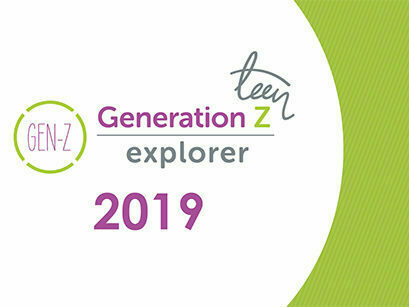As the first true generation of digital natives, Gen Z is coming of age and reshaping the world in their image. Our economy, our culture, and even our media will be forever transformed. In this post, we will take a closer look at how your brand can understand Gen Z in order to effectively communicate with them based on their values, media consumption, and lifestyle. This is a must-have resource for marketers developing their Gen Z marketing strategy to reach the influential consumers of today and tomorrow.

About Our Research
At Refuel Agency, we believe research is critical to success. That’s why we invest in proprietary teenage market research studies to ensure that we thoroughly understand our target consumers. Our Gen Z Explorer Series™ takes a deep dive into the media habits, lifestyle, and beliefs of the coveted Gen Z consumer, and is a crucial resource for marketers looking to reach this audience.
Who This Guide is For
This guide is for savvy marketers looking to understand exactly how Gen Z moves through the world—what they value, how they spend, where they spend their time, and what their relationship to brands looks like. If you’re looking to learn how to reach Gen Z through strategic, targeted media and marketing strategies—this guide is for you.
In this guide:
- Who is the Gen Z consumer?
- Gen Z spending power
- Gen Z demographics
- Gen Z is the most mobile generation to date
- Gen Z is motivated by causes
- Gen Z craves in-person experiences
- Teens are influenced by influencers
- How to advertise to high school students
- How to advertise to college students
- How to reach Gen Z this holiday season
- Gen Z marketing trends for 2025
You might be more familiar with Gen Z than you think
Have you heard the theory that generations actually cycle? Research shows that instead of each new generation exhibiting an entirely new combination of personality traits, values, and habits—that instead, each new generation mirrors one of the previous generations that came before it.
Generational expert Amy Lynch explains that grounded, pragmatic Gen Z mirrors the Silent Generation. Both Gen Z (born between 1995 and 2010) and the Silent Generation show both relative aversion to risk, and resilience and optimism. Both generations are family-focused, value making things themselves, and are financially savvy. Further, research from Refuel’s Gen Z Explorer Series™ shows that the younger generation exhibits a mix of both old-school and new-school values—that they are both loyal, religious, and ambitious, and creative, adventurous, and unique.
So while this may be a brand-new generation—you may be a little more familiar with this younger audience’s mentality and lifestyle then you may think.
Gen Z spending power is significant—and growing
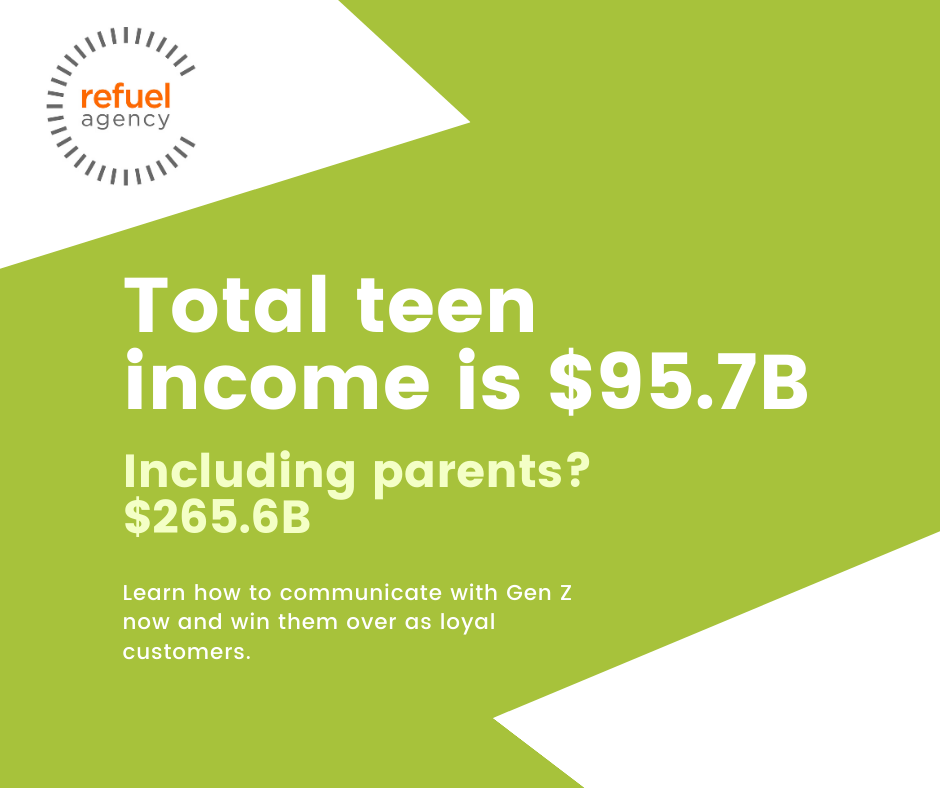
According to Refuel Agency’s Gen Z Explorer Series™, this generation encompasses 21% of the US and each year their buying power grows. Total teen income is $95.7B, but if you consider the fact that teens are often still financed by their parents as well as influencing family purchasing decisions, that spending power shoots up to a whopping $265.6B. And don’t forget – this consumer audience is made up of teenagers who haven’t started working full-time yet.
But very soon, they will be joining the workforce, earning salaries, and living out the consumer preferences they developed as teens. Learning how to communicate with and influence Gen Z now at an impressionable age before teens are earning salaries is an investment that will pay off once these teens grow into the youngest members of our workforce and their spending power grows with them.
Read next: 6 Examples of Brands That Got Gen Z Marketing Right
Gen Z is the most diverse generation yet
Gen Z is more diverse than any other generation before them. The majority of Gen Z teens are non-white (52% according to Refuel’s Gen Z Explorer Series™), compared to 29% non-white members of the Baby Boomer generation. This generation views diversity and inclusion not as an aspiration, but as their normal. In his TedX talk, Jason Dorsey explains that, “They are so diverse that they don’t see diversity… unless it’s absent.” When communicating with and marketing to this generation, your brand doesn’t have the option of not representing the diverse world into which Gen Z was born. Gen Zers support brands that showcase and celebrate the diversity they see in their own generation. A perfect example of a brand that celebrates diversity at their very core is Fluide Beauty, a “collection of colorful, cruelty-free makeup for all gender expressions, gender identities, and skin tones”. This is Gen Z branding at its finest.
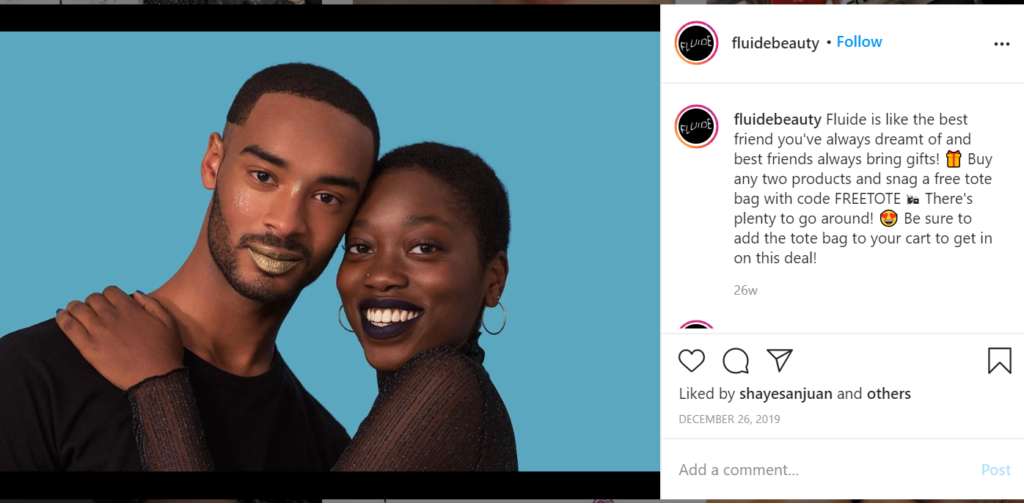
Mobile devices are a seamless extension of Gen Z’s lives

In his TedX talk on understanding Gen Z, Jason Dorsey aptly explained that, “Technology is only new if you can remember the way it was before.” When it comes to Gen Z media habits, Gen Z does not remember a time before digital media existed. Digital media, along with the communication and consumption habits it entails, define Gen Z’s normal.
Gen Zers are reported to spend as much as seven hours a day on their mobile devices, which rarely leave their hands or pockets. Fifty-nine percent of Gen Z visit brands’ websites via their smartphones (which is 37% more likely than the general population). Over two-thirds of Gen Zers use their smartphones for social media consumption, and this generation is 80% more likely to engage with a brand on social media.
Additionally, Gen Z are 28% more likely to purchase on mobile, and 84% use their mobile devices for email (GfK MRI Doublebase 2019). Smartphones are a seamless integration in Gen Z’s lives—and your brand should be, too. Gen Z carries a brand awareness and shopping tool in their hands virtually 24/7. If your digital marketing campaigns aren’t targeting mobile and your website isn’t optimized for mobile, you are losing the attention of your Gen Z target audience.
Fifty-nine percent of Gen Z visit brands’ websites via their smartphones (which is 37% more likely than the general population). Optimize your digital marketing campaigns and website for mobile to capture the Gen Z consumer audience. Click to Tweet
Gen Z is motivated by causes
According to Refuels Gen Z Explorer Series™, 48% of Gen Z are progressive on racial issues, 47% are progressive on gender issues, and 45% are progressive on environmental issues. Gen Z is highly socially conscious with a “big picture” mentality, and research shows that they value brands who support the causes they want to support. Just like Gen Z views their digital lives as an extension of their physical lives, they view the brands they support as an extension of their values and beliefs.
Gen Zers view their consumption choices as a way to support the causes they believe in, so don’t be shy about your brand’s beliefs and values. From championing diversity to raising awareness for a cause to implementing sustainable practices — invest in cause marketing and be transparent about the good you’re doing and Gen Z will take notice.
Take Lyft for example. They used their unique positioning in the mobility market to launch an initiative called “LyftUp”, focused on bringing transportation to those in America who need it most—providing grocery access, voting access, and job interview access. And to drive their campaign home with Gen Z, they leveraged the power of influencer marketing to amplify their message. Bette Ann, director of influencer marketing, shares that, “At Lyft, we’re really a mission-driven company, and we are trying to make transportation accessible for all.”
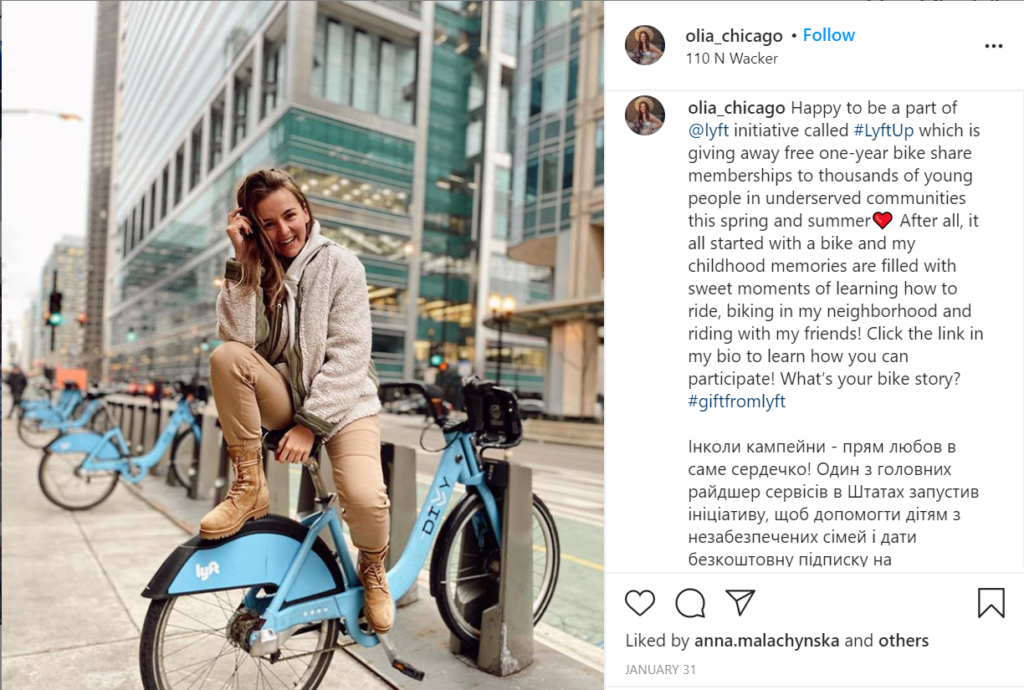
Gen Z craves interaction and experiences
Research suggests that part of what makes social media so compelling to Gen Z is the combination of creativity and interactivity. Sprout Social explains that “You can almost think of Gen Z and social media as a game of call and response”. Think Twitter polls, interactive Snapchat filters, Instagram stickers, style quizzes on your website, or giveaways.
Gen Z wants to collaborate and connect with brands—they want brands to cultivate experiences with them and enhance their personalities. Fourteen-year-old entrepreneur Mercer Henderson explains that her friends don’t use Snapchat filters that look like branded campaigns. After all, what are they getting out of using a filter with a company’s logo on in? Instead, Henderson recommends creating filters that interact with users’ personalities, like the all-time favorite puppy filter.
If you remember Starbucks’ “White Cup Contest” campaign from 2014, then you’ll understand the power of interaction and experiences for Gen Z. Starbucks encouraged customers to decorate their white cups, and they received 4,000 entries in three weeks. The winner was a 20-year-old college student from Pittsburgh. This campaign was so successful because it encouraged customers to creatively engage with the Starbucks brand.
Gen Z does the majority of their shopping offline
Even though we’ve learned that Gen Z is more likely to purchase on mobile, 2 in 3 teens still shop at brick and mortar stores—so if you’re a brand with a physical presence, don’t neglect your in-store experience. Because Gen Z prefer experiences and wants to be seen “in-the-wild”. Your brand can cater to this desire by creating a share-worthy in-store experience that will both draw Gen Z in and prompt them to share on social media and with their friends.
A great example of a brand’s in-store experience is Glossier. Glossier, a beauty brand famous for its eyebrow gel, got their start online in 2010 years before ever making an appearance in “IRL”. Once they did open up shop in New York City in 2018, though, customers could be spotted lining up for hours to gain entrance.
And while yes, they came for the makeup—they also came for the experience. Glossier created a pale pink oasis so on-brand with their skincare aesthetic that customers couldn’t help but photograph it and share it with the world. Gen Z consumers want to experience Glossier’s store as much as they want to purchase their products. And this relationship between the in-store experience and the product or service quality drives brand loyalty.
Just see for yourself!
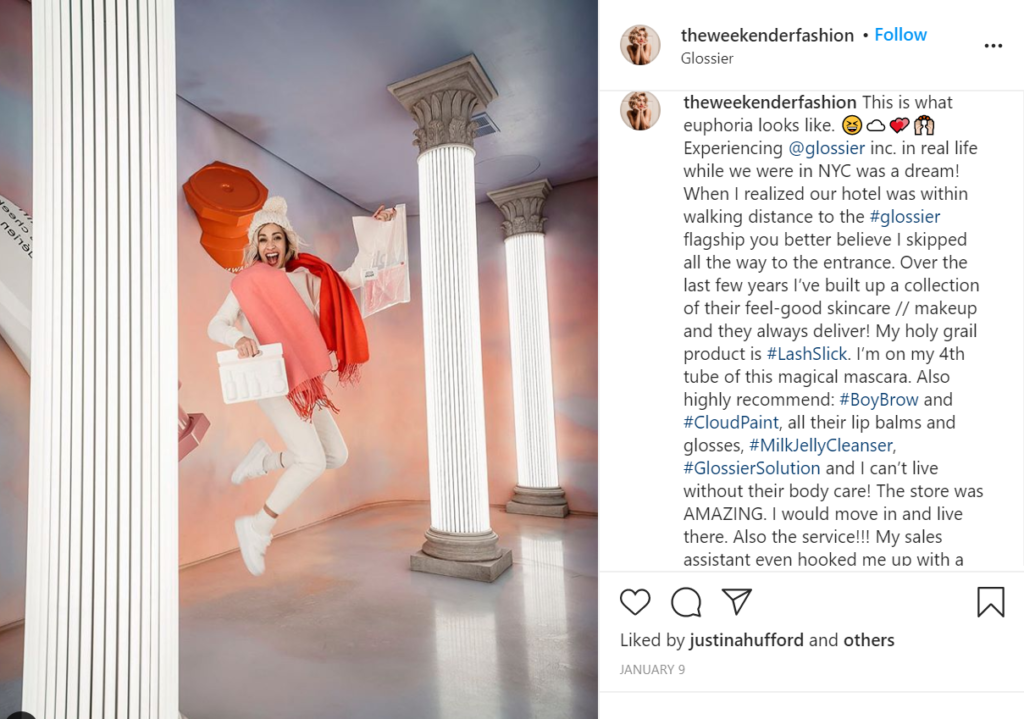
Read next: Offline Spending With Digital Natives
Teens channel their disposable income to their closets
Research shows that 41% of a teen’s disposable income goes to food and clothing. Gen Z is turning out to be the most photographed generation, and that puts a lot of pressure on teens to switch up their outfits and keep up with the fashion they see on social media. While fast fashion might have solved this problem for teens in the past, Gen Z is too aware of their own environmental impact.
So instead, Gen Zers are getting creative and expressing their unique styles. They are turning to clothing rental companies, thrift stores, and small quality brands in order to shop sustainably and uniquely. One study found that 54% of Gen Zers are actually willing to pay 10% more for sustainable goods.
Gen Z live and breathe online videos
Gen Z is well-known for having the shortest attention span of all the generations—around 8 seconds. And whether the short attention span came first or short-form video came first, what we do know is that Gen Z consumes a lot of short-form video content.
According to Refuel Agency’s Gen Z Explorer Series™, 91% of Gen Z report watching online videos every day, 84% report that they watch video streaming services, and Gen Z is 64% more likely to stream videos on their smartphones. Gen Z is partial to specifically short-form videos over long form ones. Gen Z spends more time on YouTube than on Netflix or any other streaming platforms. Most of Gen Z’s favorite influencers are from YouTube, Vine, TikTok, Snapchat, and Instagram stories.
So what’s the takeaway? Gen Z loves video content—but not just any video content. They gravitate towards influencers, whose content seems authentic and relatable, like Liza Koshy (18.7M YouTube followers) and Emma Chamberlain (9.1M YouTube followers).
Brands can take a page from their books and create video content that makes Gen Z feel more like collaborators than consumers—encouraging user generated content (UGC), filming with lo-fi aesthetics, and being subtle with branding.
Read next: What’s Hot and What’s Not: A Review of College Students’ Digital Habits
To Gen Z, authenticity matters—a lot
As we’ve covered, Gen Z puts a lot of stock into authenticity. They view their own social media as their personal brand, they’re fans of influencers who present themselves as authentic and accessible, and they value the celebration of diversity. So when brands lead with transparency, Gen Z follows.
Aerie, American Eagle’s lifestyle and underwear brand, provided a great example in its decision to ban photo retouching in 2014. This resulted in a 14% same-store sale increase. Chad Kessler, global brand president at American Eagle explains that, “Gen Z wants to support and participate in brands they believe in and that reflect them.
They are loyal to brands that they feel understand them and reflect their values. We have been a brand that stands for inclusivity, diversity, youth empowerment, and I think that resonates with this customer.”
Teens are influenced by influencers
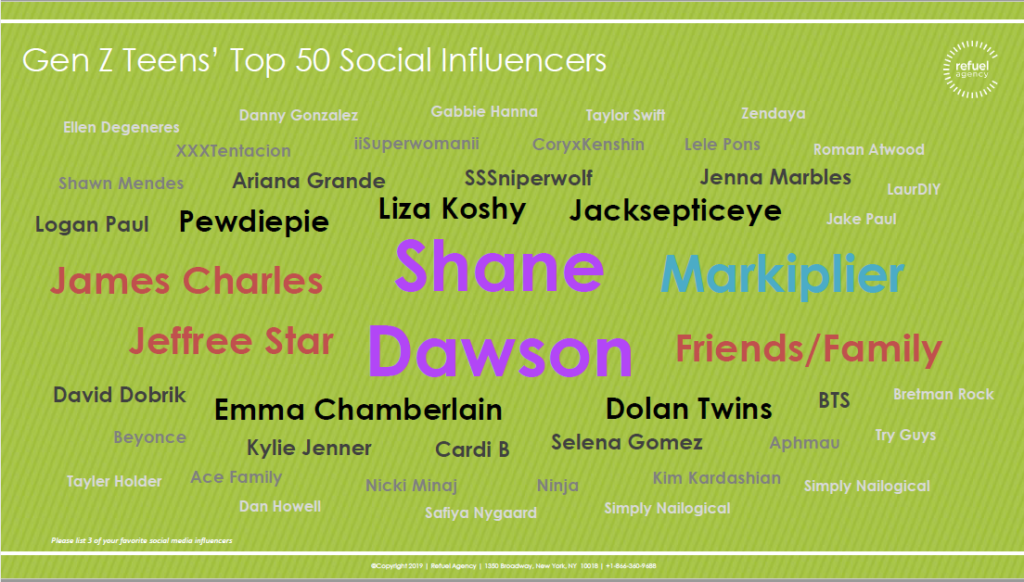
For a generation used to targeted ads and that craves authenticity, influencers offer advertisers an opportunity to better connect. Fourteen-year-old entrepreneur Mercer Henderson explains that brands that advertise through up-and-coming “personalities” are able to create a relationship with teens. Teens like to discover new personalities, and if a brand helps them do that through promoting their product, then they’re more likely to trust and like that brand.
So what kind of influencers do Gen Z like? Interestingly, Gen Z is less inclined towards movie stars or athletes. Instead, teens gravitate towards Internet personalities found on popular apps and streaming services. A few favorites include PewDiePie, Shane Dawson, Jenna Marbles, Jeffree Star, Liza Koshy, and the Dolan Twins (according to Refuel’s Gen Z Explorer Series™).
Read next: Why You Should Include Gen Z Email Marketing in Your 2024 Strategy
How to advertise to Gen Z during the holidays
Gen Z holiday shopping presents a unique opportunity for brands to connect with a highly influential demographic. Known for their digital-first lifestyles and social consciousness, Gen Zers are looking for authentic, engaging, and purpose-driven experiences. To effectively reach this audience during the holiday season, brands must prioritize inclusivity, interactive engagement, and a strong commitment to social causes.
By understanding Gen Z’s unique values and leveraging their digital platforms, marketers can create campaigns that resonate and drive holiday sales. Focus on highlighting your brand’s social impact, offering interactive shopping experiences, and partnering with influencers who align with Gen Z’s values. By tailoring your marketing efforts to this specific demographic, you can successfully tap into the Gen Z holiday market and build lasting brand loyalty.
Read next: How to Reach Gen Z This Holiday Season
How to advertise to high school students
Read next:
How to advertise to college students
Read next:
Gen Z marketing trends for 2025
Gen Z, known for their digital savviness and social consciousness, is shaping the marketing landscape. To effectively reach this demographic, brands must prioritize authenticity, inclusivity, and purpose-driven messaging.
Engaging with influencers, leveraging social media platforms like TikTok, and understanding Gen Z’s unique values are key strategies for connecting with this influential generation.
Read next: 3 Gen Z Marketing Trends to Watch
Summary
Marketing to Gen Z isn’t just important—winning over your Gen Z customers is crucial for your business’ long-term success. Luckily, understanding and influencing this customer base isn’t hard—it just requires some familiarity with a new generation’s perspective on life, what their values are, and how they interact with the world around them.
Growing up with digital media and smartphones has created a generation that is not only familiar with brands, but also views themselves as one. To Gen Z, your brand is an extension of their brand—and so this consumer audience is looking for brands that allow them to better express themselves and live out their values. Your greatest asset when advertising to Gen Z is truly to understand who they are.
